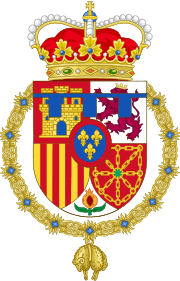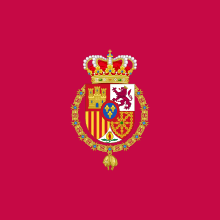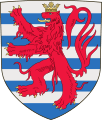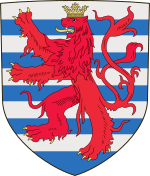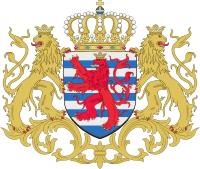Charles II of Spain
| Charles II | |||||||||||||||||||||||||||
|---|---|---|---|---|---|---|---|---|---|---|---|---|---|---|---|---|---|---|---|---|---|---|---|---|---|---|---|
 Portrait by an unknown painter of Charles II in his later years | |||||||||||||||||||||||||||
| |||||||||||||||||||||||||||
| Reign |
17 September 1665 – 1 November 1700 | ||||||||||||||||||||||||||
| Predecessor | Philip IV | ||||||||||||||||||||||||||
| Successor | Philip V | ||||||||||||||||||||||||||
| Regent | Mariana of Austria (1665–75) | ||||||||||||||||||||||||||
| Born |
6 November 1661 Royal Alcazar of Madrid, Spain | ||||||||||||||||||||||||||
| Died |
1 November 1700 (aged 38) Royal Alcazar of Madrid, Spain | ||||||||||||||||||||||||||
| Burial | El Escorial | ||||||||||||||||||||||||||
| Consorts | |||||||||||||||||||||||||||
| House | Habsburg | ||||||||||||||||||||||||||
| Father | Philip IV of Spain | ||||||||||||||||||||||||||
| Mother | Mariana of Austria | ||||||||||||||||||||||||||
| Religion | Roman Catholicism | ||||||||||||||||||||||||||
| Signature |
 | ||||||||||||||||||||||||||
Charles II of Spain (Spanish: Carlos II; 6 November 1661 – 1 November 1700), also known as El Hechizado or the Bewitched, was the last Habsburg ruler of the Spanish Empire. He is now best remembered for his physical disabilities, allegedly the result of inbreeding, and the war for his throne that followed his death.
He died childless in 1700 with no immediate Habsburg heir. His will named his successor as 16-year-old Philip of Anjou, grandson of Louis XIV and Charles's half-sister Maria Theresa.[1] Disputes over Philip's inheritance led to the War of the Spanish Succession.
Early life

Charles was born in Madrid to Philip IV of Spain and his second wife, Mariana of Austria. The only surviving son of his father's two marriages, he was given the title Prince of Asturias, traditionally held by the heir to the Spanish throne.
Philip and Mariana were uncle and niece, making Charles their son, great-nephew and first-cousin respectively; all eight of his great-grandparents were descendants of Joanna and Philip I of Castile. The impact of this inbreeding is not fully understood; his elder sister Margaret Theresa did not appear to have the same issues.[2]
Charles himself suffered ill-health throughout his life; he has been described as "short, lame, epileptic, senile and completely bald before 35, always on the verge of death but repeatedly baffling Christendom by continuing to live."[3]
In his case, the so-called Habsburg lip was so pronounced he spoke and ate only with difficulty, did not learn to talk until the age of four or walk until eight. However, foreign observers such as the Marquess of Torcy noted his mental capacities remained intact.[4]
Charles is the subject of various studies on the impact of inbreeding. It is suggested he may have had the endocrine disease acromegaly and a combination of rare genetic disorders often transmitted through recessive genes, including combined pituitary hormone deficiency and distal renal tubular acidosis.[5] However, this is speculation; the authors of the most significant state ...evidence supporting...inbreeding as an important factor in the extinction of the Spanish Habsburg lineage are...not conclusive. It has not been demonstrated...disabilities suffered by Charles II were caused by...detrimental recessive alleles inherited from common ancestors.[6]
Background; the decline of Spanish power
When Charles became King in 1665, the Spanish Empire or 'Monarchy' remained an enormous global confederation in terms of territory, but decades of war drained resources and ended Spain's supremacy in Europe. The 1568-1648 Eighty Years' War with the Dutch, the 1635-59 Franco-Spanish War and other conflicts devastated finances, while Spain was forced to accept an independent Dutch Republic in 1648.
The Kingdom of Spain comprised the two Crowns of Castile and Aragon, each with very different political cultures and traditions.[lower-alpha 1] This made it hard to enact reforms or collect taxes and government finances were in perpetual crisis. Spain declared bankruptcy nine times between 1557 and 1666, including 1647, 1652, 1661 and 1666.[7]
However, the 17th century was a period of crisis for many European states and Spain was not alone in facing these problems.[8] Feuds between those who ruled in Charles' name did little to help but it is debatable how far they or he can be held responsible for long-term trends predating his reign; the Monarchy proved remarkably resilient and when Charles died was largely intact.[9]
Reign
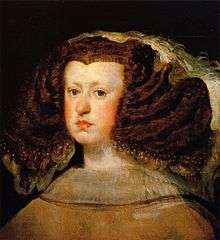
Charles was three years old when his father, Philip IV, died on 17 September 1665; as he was a legal minor, his mother Mariana was appointed Queen Regent by the Council of Castile. While Charles theoretically ruled in his own name after her death in 1696, in reality his frequent ill-health meant power was often exercised by others. This resulted in bitter internal struggles for control of government, the long feud between his mother and illegitimate half-brother John of Austria the Younger being especially damaging.
Charles' father Philip had established the system of employing personal favourites or "validos" when he appointed the Count-Duke of Olivares in 1621. Mariana simply followed this precedent, the difference being that as they had been put in office by a woman, they were more visible. The first was her personal confessor, Juan Everardo Nithard who was appointed Grand Inquisitor in 1666, placing him on the Regency Council.[lower-alpha 2]
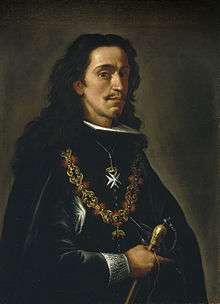
On Charles' accession, his administration had to end the long-running Portuguese Restoration War and settle the War of Devolution with France. The Spanish Crown declared bankruptcy in 1662 and 1666 and reducing Spain's military commitments was a matter of extreme urgency. In 1668, the Treaty of Aix-la-Chapelle ended the war with France and the Treaty of Lisbon accepted the restoration of the Crown of Portugal and loss of the Portuguese Empire.[10] These were simply an acceptance of reality while Aix-La-Chapelle was in many ways a diplomatic triumph, since France was forced to return most of its territorial gains. However, John exploited discontent within the ruling class to instigate a revolt in Aragon and Catalonia, compelling Mariana to dismiss Nithard in February 1669.
Nithard was replaced by Fernando de Valenzuela; when Charles turned 14 in 1675, he was legally able to rule on his own. This would have resulted in the end of the Regency while John used the opportunity to dismiss the valido. Mariana succeeded in having the Regency continued on the basis of Charles's disabilities and Valenzuela returned to court in 1677.
_and_the_Spanish_crown.jpg)
The outbreak of the Franco-Dutch War in 1672 dragged Spain into another war with France over the Spanish Netherlands, the cost of which placed almost intolerable strain on the economy. In January 1678, John finally took charge of government, expelled Mariana and exiled Valenzuela. Ironically, given his earlier opposition to the concessions made in 1668, his first act was to end the war; under the terms of the Treaties of Nijmegen, Spain ceded many of the territories in Franche-Comté and the Spanish Netherlands returned by France at Aix-la-Chapelle.
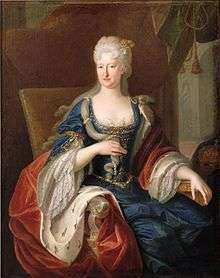
Having spent so many years achieving power, John's administration failed to live up to expectations, one of its few achievements being stabilising the currency. He faced an almost impossible situation and had insufficient time to have a real impact before his government ended with his death in September 1679. Mariana returned as Queen Regent but her influence was diminished by Charles' marriage in November 1679 to the 17-year-old Marie Louise of Orléans to whom he was devoted.
The 1683-84 War of the Reunions was a brief but devastating conflict with France over the Spanish Netherlands, followed in 1688 by the outbreak of the Nine Years' War. Shortly afterwards in February 1689, Marie Louise died; despite allegations she was poisoned, based on the description of her symptoms, modern doctors believe her illness was almost certainly appendicitis.[lower-alpha 3] In August, Charles married Maria Anna of Neuburg by proxy, the formal wedding taking place in May 1690; after his mother died on 16 May 1696, he ruled in his own name although Maria Anna played a significant role due to his ill-health and her control over access to Charles.[11]
It was clear Charles' health was finally failing and agreeing upon his successor became increasingly urgent. The Nine Years' War showed France could not achieve its objectives on its own; the 1697 Treaty of Ryswick was the result of mutual exhaustion and Louis' search for allies in anticipation of a contest over the Spanish throne. The Habsburg Emperor Leopold initially refused to sign the Treaty since it left this issue unresolved; he reluctantly did so in October 1697 but all sides viewed it as simply a pause in hostilities.[12]
The Succession
Attempts at offspring
One of John's last acts was to arrange Charles' marriage in 1679 to Marie Louise of Orléans, eldest daughter of Philippe I, Duke of Orléans. The French ambassador wrote that '...the Catholic King is so ugly as to cause fear and he looks ill' while the marriage was strongly resisted by the prospective bride but went ahead regardless.
When Mariana returned as Regent, she did her utmost to isolate Marie Louise who was French, rather than Austrian and the choice of her bitter rival. Marie Louise claimed Charles suffered from premature ejaculation; the lack of an heir made her unpopular, fertility treatments gave her severe intestinal problems and she became depressed.[13] The pressure placed on producing an heir is illustrated by the story that when an astrologer suggested Charles' sterility was due to his failure to say goodbye to his father, Mariana had Philip IV's body disinterred to allow him to do so.
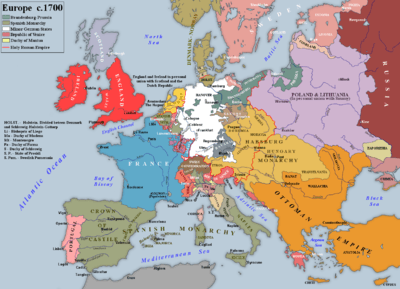
Charles was distraught when Marie Louise died in February 1689 but his declining health meant in August he married Maria Anna of Neuburg, daughter of Philip William, Elector Palatine and sister-in-law to the Emperor Leopold. As one of 12 children, she was selected for her family background of fertility but also to strengthen the pro-Austrian faction in the Spanish court; when Mariana herself died in 1696, she assumed leadership of this element.[14] The marriage was no more successful in producing an heir; after his death, Charles' autopsy revealed he had only one atrophied testicle and he was almost certainly impotent by this stage.[15]

Succession dispute
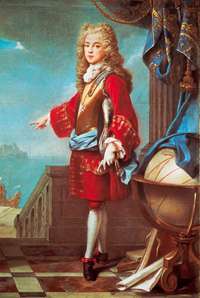
As the Crown of Spain passed according to cognatic primogeniture, it was possible for a woman, or the descendant of a woman, to inherit the crown. This enabled Charles' sisters Maria Theresa (1638-83) and Margaret Theresa (1651-1673) to pass their rights to the children of their marriages with Louis XIV and Emperor Leopold.[lower-alpha 4]
In 1685, Leopold and Margaret's daughter Maria Antonia married Max Emanuel of Bavaria; she died in 1692, leaving one surviving son, Joseph Ferdinand. In October 1698, France, Britain and the Dutch Republic attempted to impose a diplomatic solution to the Succession on Spain and Austria, by the Treaty of the Hague or First Partition Treaty. This made Joseph Ferdinand heir to the bulk of the Spanish Monarchy, with France gaining the Kingdoms of Naples and Sicily and other concessions in Italy plus the modern Basque province of Gipuzkoa. Leopold's younger son Archduke Charles became ruler of the Duchy of Milan, a possession considered vital to the security of Austria's southern border.[16]
Unsurprisingly, the Spanish objected to their Empire being divided by foreign powers without consultation, and on 14 November 1698, Charles II published his will. This made six year old Joseph Ferdinand heir to an independent and undivided Spanish Monarchy, with Maria Anna as Queen Regent during his minority, an announcement allegedly received by the Spanish councillors in silence.[17]
Joseph Ferdinand died of smallpox in 1699, leaving Louis XIV's eldest son, the Grand Dauphin as the senior surviving legitimate descendant of Philip IV; since this would lead to the union of Spain and France, an alternative was needed. In March 1700, France, Britain and the Dutch agreed the Second Partition Treaty or Treaty of London; Archduke Charles replaced Joseph Ferdinand as heir, with Spanish possessions in Europe split between France, Savoy and Austria.[18] Charles altered his Will in favour of Archduke Charles, once again stipulating an undivided and independent Spanish Monarchy.
However, much of the nobility, including Charles, disliked the Austrians and saw genuine advantages for Spain in a Bourbon candidate. In September 1700, Charles became ill again; by 28 September he was no longer able to eat and Portocarrero persuaded him to alter his Will in favour of Louis XIV's grandson, Philip of Anjou.[19] When Charles died on 1 November 1700, the throne was offered to Philip, who was proclaimed King of Spain on 16 November 1700. This was accepted by Britain and the Dutch Republic among others but disputes over division of territories and commercial rights led to the War of the Spanish Succession in 1701.[20]
Death

Toward the end of his life, Charles's fragile health deteriorated; he officially retired when he had a nervous breakdown caused by the stress of Spain's economic issues and conflict over his successor.
He died in Madrid five days before his 39th birthday on 1 November 1700, the 39th anniversary of the death of his elder brother Philip. The physician who performed his autopsy stated his body "did not contain a single drop of blood; his heart was the size of a peppercorn; his lungs corroded; his intestines rotten and gangrenous; he had a single testicle, black as coal, and his head was full of water."[21]
His life was memorably summarised by John Langdon-Davies as follows: "We are dealing with a man who died of poison two hundred years before he was born. If birth is a beginning, of no man was it more true to say that in his beginning was his end. From the day of his birth they were waiting for his death."[22]
Legacy
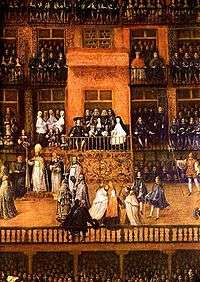
In his role as monarch, Charles presided over the largest ever public auto-da-fés in 1680 and 1691, the latter resulting in the death of more than 37 victims. It has been suggested his disgust at this led to the process that ultimately broke the power of the Inquisition over Spanish society and that this forms part of his legacy.
When he came to the throne, the Inquisition remained a significant force but its influence had declined and the auto-da-fé were an attempt to publicly assert its power, rather than increased religiosity. While Charles certainly played a role, its downfall was largely the result of the political struggle over his heir. In 1700, the Inquisitor General, Balthasar de Mendoza, Bishop of Segovia arrested Charles' personal confessor Froilán Díaz on a charge of 'bewitching' the King.[lower-alpha 5] When he was found Not Guilty, Mendoza attempted to arrest those who voted for his acquittal, resulting in the establishment of a Council to investigate the Inquisition; it survived as an institution until 1834 but with little power.[23]
More tangible memorials include Charleroi in modern Belgium and the Caroline Islands, which were named after him in 1666 and 1686 respectively.
Heraldry
| Heraldry of Charles II of Spain | ||||||||||||||
|---|---|---|---|---|---|---|---|---|---|---|---|---|---|---|
|
Ancestry
| Ancestors of Charles II of Spain | ||||||||||||||||||||||||||||||||||||||||||||||||||||||||||||||||||||||||||||||||||||||||||||||||||||||||||||||||||||||||||||||||||||||||||||||||||||||||||||||||||||||||||||||||||||||||||||||||||||||||||||||||||||||||||||||||||||||||||||||||||||||||||||||||||||||||||||||||||||||||||||||||||||||||||||||||||||||||||||||||||||||||||||||||||||||||||||||||||||||||||||||||||||||||||||||||||||||||||||||||||||||||||||||||||||||||||||||||||||||||||||||||||||||||||||||||||||||||||||||||||||||||||||||||||||||||||||||||||||||||||||||||||||||||||||||||||||||||||||||||||||||||||||||||||||||||||||||||||||||||||||||||||||||||||||||||||||||||||||||||||||||||||||||||||||||||||||||||||||||||||||||||||||||||||||||||||||||||||||||||||||||||||||||||||||||||||||||||||||||||||||||||||||||||||||||||||||||||||||||||||||||||||||||||||||||||||||||||||||||||||||||||
|---|---|---|---|---|---|---|---|---|---|---|---|---|---|---|---|---|---|---|---|---|---|---|---|---|---|---|---|---|---|---|---|---|---|---|---|---|---|---|---|---|---|---|---|---|---|---|---|---|---|---|---|---|---|---|---|---|---|---|---|---|---|---|---|---|---|---|---|---|---|---|---|---|---|---|---|---|---|---|---|---|---|---|---|---|---|---|---|---|---|---|---|---|---|---|---|---|---|---|---|---|---|---|---|---|---|---|---|---|---|---|---|---|---|---|---|---|---|---|---|---|---|---|---|---|---|---|---|---|---|---|---|---|---|---|---|---|---|---|---|---|---|---|---|---|---|---|---|---|---|---|---|---|---|---|---|---|---|---|---|---|---|---|---|---|---|---|---|---|---|---|---|---|---|---|---|---|---|---|---|---|---|---|---|---|---|---|---|---|---|---|---|---|---|---|---|---|---|---|---|---|---|---|---|---|---|---|---|---|---|---|---|---|---|---|---|---|---|---|---|---|---|---|---|---|---|---|---|---|---|---|---|---|---|---|---|---|---|---|---|---|---|---|---|---|---|---|---|---|---|---|---|---|---|---|---|---|---|---|---|---|---|---|---|---|---|---|---|---|---|---|---|---|---|---|---|---|---|---|---|---|---|---|---|---|---|---|---|---|---|---|---|---|---|---|---|---|---|---|---|---|---|---|---|---|---|---|---|---|---|---|---|---|---|---|---|---|---|---|---|---|---|---|---|---|---|---|---|---|---|---|---|---|---|---|---|---|---|---|---|---|---|---|---|---|---|---|---|---|---|---|---|---|---|---|---|---|---|---|---|---|---|---|---|---|---|---|---|---|---|---|---|---|---|---|---|---|---|---|---|---|---|---|---|---|---|---|---|---|---|---|---|---|---|---|---|---|---|---|---|---|---|---|---|---|---|---|---|---|---|---|---|---|---|---|---|---|---|---|---|---|---|---|---|---|---|---|---|---|---|---|---|---|---|---|---|---|---|---|---|---|---|---|---|---|---|---|---|---|---|---|---|---|---|---|---|---|---|---|---|---|---|---|---|---|---|---|---|---|---|---|---|---|---|---|---|---|---|---|---|---|---|---|---|---|---|---|---|---|---|---|---|---|---|---|---|---|---|---|---|---|---|---|---|---|---|---|---|---|---|---|---|---|---|---|---|---|---|---|---|---|---|---|---|---|---|---|---|---|---|---|---|---|---|---|---|---|---|---|---|---|---|---|---|---|---|---|---|---|---|---|---|---|---|---|---|---|---|---|---|---|---|---|---|---|---|---|---|---|---|---|---|---|---|---|---|---|---|---|---|---|---|---|---|---|---|---|---|---|---|---|---|---|---|---|---|---|---|---|---|---|---|---|---|---|---|---|---|---|---|---|---|---|---|---|---|---|---|---|---|---|---|---|---|---|---|---|---|---|---|---|---|---|---|---|---|---|---|---|---|---|---|---|---|---|---|---|---|---|---|---|---|---|---|---|---|---|---|---|---|---|---|---|---|---|---|---|---|---|---|---|---|---|---|---|---|---|---|---|---|---|---|---|---|---|---|---|---|---|---|---|---|---|---|---|---|---|---|---|---|---|---|---|---|---|---|---|---|---|---|---|---|---|---|---|---|---|---|---|---|---|---|---|---|---|---|---|---|---|---|---|---|---|---|---|---|---|---|---|---|---|---|---|---|---|---|---|---|---|---|---|---|---|---|---|---|---|---|---|---|---|---|---|---|---|---|---|---|---|---|---|---|---|---|---|---|---|---|---|---|---|---|---|---|---|---|---|---|---|---|---|---|---|---|---|---|---|---|---|---|---|---|---|---|---|---|---|---|---|---|---|---|---|---|---|---|---|---|---|---|---|---|---|---|---|---|---|---|---|---|---|---|---|---|---|---|---|---|---|---|---|---|---|---|---|---|---|---|---|
| ||||||||||||||||||||||||||||||||||||||||||||||||||||||||||||||||||||||||||||||||||||||||||||||||||||||||||||||||||||||||||||||||||||||||||||||||||||||||||||||||||||||||||||||||||||||||||||||||||||||||||||||||||||||||||||||||||||||||||||||||||||||||||||||||||||||||||||||||||||||||||||||||||||||||||||||||||||||||||||||||||||||||||||||||||||||||||||||||||||||||||||||||||||||||||||||||||||||||||||||||||||||||||||||||||||||||||||||||||||||||||||||||||||||||||||||||||||||||||||||||||||||||||||||||||||||||||||||||||||||||||||||||||||||||||||||||||||||||||||||||||||||||||||||||||||||||||||||||||||||||||||||||||||||||||||||||||||||||||||||||||||||||||||||||||||||||||||||||||||||||||||||||||||||||||||||||||||||||||||||||||||||||||||||||||||||||||||||||||||||||||||||||||||||||||||||||||||||||||||||||||||||||||||||||||||||||||||||||||||||||||||||||
| Notes:
| ||||||||||||||||||||||||||||||||||||||||||||||||||||||||||||||||||||||||||||||||||||||||||||||||||||||||||||||||||||||||||||||||||||||||||||||||||||||||||||||||||||||||||||||||||||||||||||||||||||||||||||||||||||||||||||||||||||||||||||||||||||||||||||||||||||||||||||||||||||||||||||||||||||||||||||||||||||||||||||||||||||||||||||||||||||||||||||||||||||||||||||||||||||||||||||||||||||||||||||||||||||||||||||||||||||||||||||||||||||||||||||||||||||||||||||||||||||||||||||||||||||||||||||||||||||||||||||||||||||||||||||||||||||||||||||||||||||||||||||||||||||||||||||||||||||||||||||||||||||||||||||||||||||||||||||||||||||||||||||||||||||||||||||||||||||||||||||||||||||||||||||||||||||||||||||||||||||||||||||||||||||||||||||||||||||||||||||||||||||||||||||||||||||||||||||||||||||||||||||||||||||||||||||||||||||||||||||||||||||||||||||||||
Both Philip II of Spain and Charles II, Archduke of Austria, the patrilineal great-grandfathers of Charles II of Spain's father and mother respectively, were grandsons of Joanna and Philip I of Castile and married their own nieces. Philip II's son and successor, Philip III of Spain, married Archduke Charles's daughter Margaret. They were the parents of Charles II of Spain's father and maternal grandmother. Margaret's brother Holy Roman Emperor Ferdinand II and his wife and first cousin, Maria Anna of Bavaria, were the parents of the Spanish king's maternal grandfather.
Notes
- ↑ The Crown of Aragon was divided into the Kingdoms of Aragon, Catalonia, Valencia, Majorca, Naples, Sicily, Malta and Sardinia.
- ↑ Modern assessments of Mariana tend to reflect contemporary views that a woman without a husband was almost unnatural and 'favourite' often gets interpreted as lover. John did no better when he finally achieved power in 1678.
- ↑ In an era when many illnesses were poorly understood, poison was often suggested as the cause.
- ↑ Ironically, Hapsburg attempts to apply this principle to Austria would lead to the War of the Austrian Succession in 1740.
- ↑ Mendoza was an ally of the pro-Austrian Queen Maria Anna while Díaz was considered pro-French and given Charles' declining health had considerable influence over him.
References
- ↑ Kamen, Henry (2001). Philip V of Spain: The King who Reigned Twice. Yale University Press. ISBN 0-300-08718-7.
- ↑ Callaway, Ewen. "Inbred Royals show traces of natural selection". Nature.com. Nature; International Weekly Journal of Science. Retrieved 9 April 2018.
- ↑ Durant, Ariel, Durant, Will (1963). Age of Louis XIV (Story of Civilization). TBS Publishing. ISBN 0207942277.
- ↑ Onnekink, David (ed) Mijers, Esther (ed), Rule, John (2017). The Partition Treaties, 1698-1700; A European View in Redefining William III: The Impact of the King-Stadholder in International Context. Routledge. pp. 91–108. ISBN 1138257966.
- ↑ Callaway, Ewen (19 April 2013). "Inbred Royals Show Traces of Natural Selection". Nature News. Retrieved 7 July 2016.
- ↑ Gonzalo, Alvarez, Ceballos, Francisco; Quintero Celsa (2009). "The Role of Inbreeding in the Extinction of a European Royal Dynasty". PLOS. doi:10.1371/journal.pone.0005174. Retrieved 12 April 2018.
- ↑ Jon Cowans (2003). Modern Spain: A Documentary History. U. of Pennsylvania Press. pp. 26–27. ISBN 0-8122-1846-9.
- ↑ de Vries, Jan (2009). "The Economic Crisis of the 17th Century" (PDF). Journal of Interdisciplinary Studies. 40 (2): 151–194. Retrieved 7 April 2018.
- ↑ Storrs, Christopher (2006). The Resilience of the Spanish Monarchy 1665-1700. OUP Oxford. pp. 6–7. ISBN 0199246378.
- ↑ Barton, Simon (2009). A History of Spain. ISBN 978-0230200111.
- ↑ Onnekink, David (ed) Mijers, Esther (ed), Rule, John (2017). The Partition Treaties, 1698-1700; A European View in Redefining William III: The Impact of the King-Stadholder in International Context. Routledge. pp. 91–108. ISBN 1138257966.
- ↑ Meerts, Paul Willem (2014). Diplomatic negotiation: Essence and Evolution. http://hdl.handle.net/1887/29596: Leiden University dissertation. p. 168.
- ↑ García-Escudero López, Ángel, Arruza Echevarría A, Padilla Nieva and R. Puig Giró1, Padilla Nieva, Jaime, Puig Giró, Ramon (2009). "Charles II; from spell to genitourinary pathology". History of Urology. 62 (3): 181.
- ↑ Rommelse, Gijs (2011). Ideology and Foreign Policy in Early Modern Europe (1650–1750). Routledge. p. 224. ISBN 1409419134.
- ↑ García-Escudero López, Ángel, Arruza Echevarría A, Padilla Nieva and R. Puig Giró1, Padilla Nieva, Jaime, Puig Giró, Ramon (2009). "Charles II; from spell to genitourinary pathology". History of Urology. 62 (3): 182.
- ↑ Ward, William,, Leathes, Stanley (1912). The Cambridge Modern History (2010 ed.). Nabu. p. 384. ISBN 1174382058.
- ↑ Ward, William,, Leathes, Stanley (1912). The Cambridge Modern History (2010 ed.). Nabu. p. 385. ISBN 1174382058.
- ↑ McKay, Derek, Scott, HM (1983). The Rise of the Great Powers 1648 - 1815 (The Modern European State System). Routledge. pp. 54–55. ISBN 0582485541.
- ↑ Hargreaves- Mawdsley, HN (1979). Eighteenth-Century Spain 1700-1788: A Political, Diplomatic and Institutional History. Macmillan. pp. 15–16. ISBN 0333146123.
- ↑ Falkner, James (2015). The War of the Spanish Succession 1701-1714 (Kindle ed.). 96: Pen and Sword. ISBN 9781473872905.
- ↑ Gargarilla, Pedro. "Enfermedades de los reyes de España. Los Austrias : de la locura de Juana a la impotencia de Carlos II el Hechizado" La Esfera de los Libros S.L., 2005. ISBN 8497343387
- ↑ Langdon-Davies, John (1963). Carlos; the King Who Would Not Die. Prentice Hall. ASIN B0006AYR3A. OCLC 1117405.
- ↑ Kamen, Henry (1965). The Spanish Inquisition: A Historical Revision (2014 ed.). Yale University Press. p. 185. ISBN 0300180519.
Sources
- Will Durant, The Reformation (1957)
- Will and Ariel Durant, The Age of Louis XIV (1963)
- Martin Andrew Sharp Hume, The Year After the Armada, and other historical studies (1896)
- Henry Kamen, The Spanish Inquisition (1997)
- John Langdon-Davies, Carlos, the Bewitched, the last Spanish Hapsburg, 1661-1700, London (1962)
- Ludwig Pfandl, Karl II. Das Ende der spanischen Machtstellung in Europa, Munich (1940)
External links

Charles II of Spain Born: November 6 1661 Died: November 1 1700 | ||
| Regnal titles | ||
|---|---|---|
| Preceded by Philip IV |
King of Spain, Sardinia, Naples and Sicily Duke of Milan, Lothier, Brabant, Limburg and Luxemburg Count of Flanders, Hainaut and Namur 1665–1700 |
Succeeded by Philip V |
| Count Palatine of Burgundy 1665–1678 |
Lost to France Treaties of Nijmegen | |
| Spanish royalty | ||
| Vacant Title last held by Philip Prospero |
Prince of Asturias 1661–1665 |
Vacant Title next held by Louis Philip |
.svg.png)
.svg.png)

.svg.png)
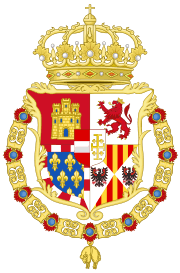
.svg.png)
.svg.png)
